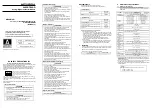
2 (E)
Overview
The BKPF-012A is a 4:2:2-4fsc NTSC converter board
which converts a 525-line, 4:2:2 component serial
digital video signal into an NTSC composite serial
digital video signal. This board has a frame
synchronizing function which synchronizes a
composite video signal with a reference signal then
outputs the signal. With this function, a multiplexed
audio signal can be added to the converted video
signal.
This board is designed to be installed and operated in
the PFV-D10, PFV-D50A or PFV-D300 Digital Video
Interface Unit. The necessary operating power is
supplied via the interface unit.
The BKPF-012A is compatible in structure and power
voltage with other optional boards designed for the
PFV-D10/D50A/D300 Digital Video Interface Unit.
The boards can be mounted in these interface units in
any combination.
Note
For setting the switches on the board, consult a
qualified service technician.
The BKPF-012A is composed of the following items.
Board (1)
Connector panel (1)
Operation Manual (1)
Installation Manual (1)
Functions of the BKPF-012A
Setting the lock mode
The signal can be synchronized with either an input
signal or a reference signal and be output. When it is
synchronized with a reference signal, the frame
synchronizer function can be turned on or off.
The phase of the output signal can be advanced by 2H
or 1H or delayed by 1H, or alined with a reference
signal depending on the internal switch setting.
Phase adjustment of an output signal
The output signal phase can be adjusted.
Serial digital output: 70-ns steps
Analog NTSC output: 17.5-ns steps
Setup function
It is possible to add 7.5% setup to an output signal.
Auto-freeze function
When the supply of the input signal is stopped with an
output signal synchronized with a reference signal, the
frame just before the input signal was stopped can be
continuously output by setting the internal switch
appropriately (with the frame synchronizer ON).
Selection of the Q-filter band
The Q-axis band for converting a composite signal can
be set to either 1.5 MHz, the same as the I-axis band,
or 0.5 MHz with the internal switch setting.
Video phase-shift function
When an output signal is synchronized with a
reference signal, and a signal with a color-frame data
multiplexed, such as a signal of a digital Betacam
VTR, the video-signal phase can be shifted with an
internal switch setting to avoid frequency dips if color
frames of the input signal and reference signal are not
aligned.
When an output signal is synchronized with an input
signal, the signal is encoded with the color frame if the
color-frame data are multiplexed to the input signal.
EDH detection and addition function
If an EDH signal is multiplexed to an input signal,
errors in the input signal can be detected. The EDH
signal is multiplexed to an output signal.
ISR function
This board conforms to the format of the ISR
(Interactive Status Reporting) system.
































